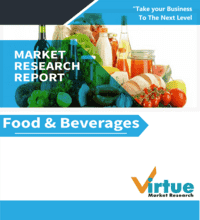Beauty Drinks Market Size (2025 – 2030)
The Global Beauty Drinks Market was valued at USD 2.2 billion in 2024 and will grow at a CAGR of 14% from 2025 to 2030. The market is expected to reach USD 4.8 billion by 2030.
The Beauty Drinks Market centers on ingestible beverages formulated with collagen, hyaluronic acid, biotin, vitamins, minerals, carotenoids, ceramides, probiotics, and botanical antioxidants aimed at supporting skin elasticity, hydration, hair strength, nail health, and overall glow. Delivered as ready-to-drink shots, cans, tonics, concentrates, or dissolvable liquid sachets, these products sit at the intersection of beauty and wellness. Accelerating consumer interest in holistic self-care, clean label formulations, and preventative aging is expanding the category across pharmacies, grocery, beauty retail, and direct-to-consumer channels. Brands leverage science-backed positioning, clinical claims, and convenient daily routines to drive repeat purchase and subscription adoption.
Key Market Insights:
Online and direct-to-consumer accounted for about 27% of category value in 2024, supported by subscriptions and replenishment bundles.
Asia-Pacific represented roughly 39% of value in 2024, with strong uptake in Japan, South Korea, China, and Southeast Asia.
Sugar-free and low-calorie formulations reached near 35% of launches, aligning with weight and metabolic wellness goals.
Average realized price per 50–100 ml beauty shot ranged from USD 2.20–4.10 depending on active concentration and packaging.
Retail pharmacies and beauty specialty chains delivered about 31% of value, driven by advice-led shopping and regimen building.
Repeat purchase rates for subscription buyers exceeded 60% at month six where brands offered clinical-style progress tracking.
Cross-functional blends featuring collagen plus hyaluronic acid grew around 18% year-on-year, outperforming single-ingredient products.
Global Beauty Drinks Market Drivers
Rising consumer demand for inside-out beauty solutions is driving the market growth
Consumers increasingly view skin, hair, and nail health as outcomes of whole-body wellness rather than surface-level care alone. This mindset elevates nutrition, sleep, stress management, and hydration to the same importance as serums or creams, creating fertile ground for ingestible beauty. Beauty drinks uniquely translate this philosophy into convenient, habit-forming rituals—morning shots, post-workout can formats, and bedtime tonics so adherence is naturally higher than for powders that require mixing or capsules perceived as medicinal. Brands underscore daily micro-dosing, positioning beverages as a simple path to cumulative benefits such as elasticity support, improved barrier function, and stronger keratin structures. Visual proof points have matured as well: before-and-after photography, dermal ultrasound images, and dermatologist-validated questionnaires now accompany product pages and shelf talkers, giving consumers confidence to trial. Social media accelerates acceptance by turning routines into shareable content and normalizing collagen coffees or hyaluronic spritzers. The category also benefits from the long runway of preventative beauty; shoppers in their twenties and thirties adopt ingestibles to delay visible aging, while older cohorts seek maintenance and recovery. Because beverages can combine multiple actives at palatable doses, brands craft comprehensive blends that address hydration, oxidative stress, and micro-inflammation simultaneously. This breadth enables portfolio architectures tailored to different priorities glow, firmness, clarity, or scalp vitality without overwhelming users with complex pill stacks. As the inside-out model becomes mainstream and retailers curate “ingestible beauty” bays next to topicals, demand momentum builds, reinforcing beauty drinks as a cornerstone of modern self-care.
Scientific validation and clinically framed product storytelling is driving the market growth
A decisive driver for category expansion is the migration from vague wellness promises to clinically framed, measurable outcomes. Collagen peptides standardized by molecular weight distribution, rice-derived ceramides, stabilized vitamin C, zinc, selenium, and carotenoid complexes are now presented with references to randomized or observational studies, dosage ranges, and time-to-benefit windows. Brands increasingly invest in small-scale in-house trials or partner with third-party labs to substantiate elasticity improvements, wrinkle depth reductions, and hydration metrics. This evidence language travels well across channels: pharmacy staff can counsel consumers using clear protocols, dermatologists and nutritionists integrate products into comprehensive regimens, and e-commerce pages communicate dosage, compliance tips, and progress tracking. Packaging reinforces credibility through ingredient provenance, analytical certificates, and QR codes linking to data summaries while avoiding therapeutic overreach. Consumer education around bioavailability such as the role of peptide size, fat-soluble vitamin carriers, or co-factors like copper and silica helps demystify efficacy and reduces skepticism. As products become more measurable and professionalized, shoppers are willing to commit to multi-month programs, increasing lifetime value and smoothing demand. The net effect is a maturing market where science-backed narratives communicated accessibly drive trust, repeat purchase, and category legitimacy among both beauty enthusiasts and wellness pragmatists.
Global Beauty Drinks Market Challenges and Restraints
Regulatory fragmentation, claims risk, and compliance overhead is restricting the market growth
The category’s momentum is tempered by a patchwork of regulations across food, beverage, and supplement frameworks. Permissible ingredients, maximum daily dosages, fortification limits, and labeling requirements differ by country—and sometimes by state—creating costly reformulation and documentation burdens for brands pursuing multi-region scale. Claims enforcement is particularly sensitive: words implying prevention or treatment can trigger drug-style scrutiny, while ambiguous “beauty from within” statements may fail to persuade discerning shoppers. Navigating allowable structure-function language, mandatory disclaimers, and age or pregnancy advisories requires legal review and ongoing monitoring of guidance updates. Import controls, positive lists for collagen sources, allergen labeling, and sugar taxes further complicate route-to-market strategies. Advertising policies on major platforms restrict audience targeting and require substantiation for efficacy claims, raising creative and media costs. Retailers add another layer by demanding quality assurance packages, stability data, and third-party certifications. Smaller brands face disproportionate compliance overhead, slowing innovation cadence and hindering international expansion. When compliance missteps occur—poorly phrased ads, overstated benefits, or undeclared allergens—penalties, delistings, and reputational damage can follow, chilling investment. The need to harmonize scientific storytelling with conservative, jurisdiction-specific claim frameworks remain a structural restraint on the category’s otherwise rapid growth.
Market Opportunities
Beauty drinks are primed to benefit from sophisticated portfolio design, precision personalization, and credible sustainability. Brands can architect laddered product ranges that map concern intensity to ingredient potency and serving frequency—daily maintenance shots for hydration and antioxidant support, step-up formulas with clinically dosed collagen for elasticity, and targeted blends for scalp or nail strength. Personalization engines can combine quiz inputs, lifestyle data, and skin photography to recommend starter kits, flavor preferences, and schedule reminders, improving trial conversion and long-term adherence. Subscriptions can be tiered with rotating flavors, limited seasonal botanicals, and loyalty perks tied to consistent usage milestones tracked in apps. Cross-category bundling—pairing a collagen tonic with a ceramide serum—creates holistic rituals and lifts basket size. In retail, small-format coolers near beauty fixtures, sample-size shots for travel, and QR-enabled education can accelerate discovery. Science partnerships with dermatology clinics, esthetic practices, and sports nutritionists raise credibility and funnel high-intent consumers. Emerging markets offer white-space as modern trade expands and social commerce accelerates; localized flavors and culturally resonant beauty ideals differentiate assortments. Sustainability can become a growth wedge through recyclable cans, lightweight bottles, plant-based collagen alternatives, and traceable marine sources with third-party verification. Finally, manufacturing innovation—aseptic filling, nitrogen dosing, and light-protective packaging—extends potency and reduces preservatives, helping clean label ambitions without sacrificing shelf life. Combining these levers positions beauty drinks to capture durable, premium growth across 2025–2030.
BEAUTY DRINKS MARKET REPORT COVERAGE:
|
REPORT METRIC |
DETAILS |
|
Market Size Available |
2023 - 2030 |
|
Base Year |
2023 |
|
Forecast Period |
2024 - 2030 |
|
CAGR |
14% |
|
Segments Covered |
By product, application, and Region |
|
Various Analyses Covered |
Global, Regional & Country Level Analysis, Segment-Level Analysis, DROC, PESTLE Analysis, Porter’s Five Forces Analysis, Competitive Landscape, Analyst Overview on Investment Opportunities |
|
Regional Scope |
North America, Europe, APAC, Latin America, Middle East & Africa |
|
Key Companies Profiled |
Shiseido, Suntory Wellness, FANCL, DHC, Yakult Honsha, Vital Proteins, Nestlé Health Science, The Bountiful Company, Amway, Goli, Herbalife, Perrigo, NeoCell, Revive Collagen, Vida Glow |
Beauty Drinks Market Segmentation
Beauty Drinks Market segmentation By Product
- Collagen beauty shots and ready-to-drink tonics
- Hyaluronic acid hydration beverages
- Ceramide-enriched skin barrier drinks
- Multivitamin and antioxidant glow blends
- Probiotic and prebiotic beauty beverages
- Plant-based collagen booster formulations
- Specialized hair and nail strength elixirs
The most dominant product segment is collagen beauty shots and ready-to-drink tonics. Leadership stems from high consumer awareness of collagen’s role in elasticity and firmness, broad clinical reference points supporting specific dose ranges, and flexible flavor systems that mask protein notes. Single-serve shots promote daily adherence and subscription suitability, while multi-week programs deliver perceived milestones, encouraging repeat. Collagen also layers well with co-factors like vitamin C, copper, and hyaluronic acid, enabling premium bundles and tiered pricing that retailers can merchandise clearly.
Beauty Drinks Market segmentation By Application
- Pharmacies and drugstores
- Beauty specialty retail and salons
- Supermarkets and hypermarkets
- Convenience and fitness channels
- Online direct-to-consumer stores
- Online marketplaces and quick commerce
The most dominant application segment is pharmacies and drugstores. Advice-led environments fit clinically framed beauty beverages, allowing staff to guide dosage, time-to-benefit, and regimen pairing. End-caps and planograms integrate ingestibles with topical routines, driving cross-category baskets. Pharmacist credibility reduces skepticism compared with general grocery. Cold-box placement for shots increases impulse trial, while loyalty programs and refill reminders support adherence. As pharmacies expand dermo-cosmetic services and skin diagnostics, beauty drinks tie naturally into personalized care pathways and drive high-frequency repeat purchase. (120 words)
Beauty Drinks Market Regional segmentation
• North America
• Europe
• Asia‑Pacific
• Latin America
• Middle East & Africa
Asia-Pacific is the dominant region in the beauty drinks market during 2025–2030. The region’s leadership is underpinned by culturally embedded ingestible beauty traditions, high acceptance of functional beverages, and sophisticated beauty retail ecosystems. Japan and South Korea have long normalized collagen and hyaluronic formats, setting taste and packaging standards subsequently adopted elsewhere. China’s digital commerce scale and social content engines accelerate discovery, while Southeast Asian markets embrace convenience shots and sachets suitable for on-the-go lifestyles. Regional manufacturers are adept at precise flavor balancing and micro-dosing, enhancing adherence without heavy sweetness. Pharmacies, beauty specialty chains, and cross-border e-commerce operate in tandem, enabling fast rollout of innovations. Regulatory frameworks in several Asia-Pacific markets allow clear structure-function communication when substantiated, supporting professional consultation at store level. Supply proximity to marine collagen, rice-derived ceramides, and botanical farms aids cost competitiveness and traceability narratives. Together, these factors consolidate Asia-Pacific’s share and set the pace for format and flavor experimentation that informs global roadmaps.
COVID-19 Impact Analysis on the Beauty Drinks Market
With salons and clinics restricted, consumers redirected spending toward at-home regimens that combined topicals with nutrition, making ingestible beauty a natural extension. Beauty drinks offered convenience and a sense of control at a time when routines were upended. Brands shifted innovation toward daily shots and minimal-prep tonics, emphasizing hydration, barrier support, and antioxidant protection as mask-wearing, screen time, and stress affected skin. E-commerce adoption surged, and subscription models grew as shoppers sought uninterrupted supply during mobility limits. At the same time, supply chain volatility exposed vulnerabilities: ingredient lead times lengthened, packaging materials tightened, and freight costs climbed. This pressure catalyzed dual-sourcing, forecasting upgrades, and packaging light-weighting that continue to benefit operations. As restrictions eased, many behaviors persisted—morning wellness rituals, progress tracking in apps, and a willingness to invest in preventative care. The pandemic also heightened scrutiny of efficacy and claims, pushing brands toward clearer substantiation and transparent communication. Retailers responded by dedicating shelf space to ingestible beauty and training staff to bridge nutrition and skincare conversations. Overall, COVID-19 elevated the category from niche to mainstream consideration and created a durable foundation of habits, omnichannel infrastructure, and compliance discipline that sustains growth through the forecast period.
Latest trends/Developments
Brands are refining flavor and texture through enzyme-treated proteins, microencapsulation, and natural acidulants that minimize aftertaste while enabling lower sugar. Clean label remains a priority, with short ingredient lists, natural colors, and non-GMO sourcing increasingly standard. Hybridization is expanding across concerns, pairing collagen with ceramides and hyaluronic acid or blending antioxidants with probiotics to address barrier and microbiome health together. Zero-alcohol social wellness occasions are rising, pushing spritz-style beauty beverages in slim cans for evening rituals. Sustainability advances include recycled aluminum, bio-based caps, plant-origin collagen alternatives, and verified marine sources with traceability dashboards. Distribution is evolving as pharmacies add diagnostic kiosks, beauty specialists stock chilled shot fridges, and fitness chains host post-class coolers. Digital retail media features “ingredient storefronts” where shoppers filter by benefits and dosage clarity. Clinician-brand collaborations are more common, producing co-developed SKUs and outcome tracking. Finally, regulatory momentum favors standardized lexicons for dosage and benefit windows, helping consumers compare offerings. These developments collectively move the category toward higher efficacy, better taste, credible claims, and omnichannel accessibility, reinforcing premium growth while widening entry points for new users.
Key Players:
- Shiseido
- Suntory Wellness
- FANCL
- DHC
- Yakult Honsha (functional beverages portfolio)
- Vital Proteins
- Nestlé Health Science
- The Bountiful Company (collagen brands)
- Amway
- Goli Nutrition
- Herbalife
- Perrigo
- NeoCell
- Revive Collagen
- Vida Glow
The beauty drinks market is experiencing a significant surge, with a strong focus on ingredients and product innovation. This trend is supported by new product launches, such as the "Athena's Glow Drink" unveiled in June 2025 by MAR Advantage, which is specifically formulated with natural ingredients for women over 45. In addition, the market is seeing a rise in specialized products, with a report from July 2025 noting a new electrolyte-rich lip balm by Milk Makeup, which acts as a "sports drink for your lips," and a collagen-focused moisturizer by Neutrogena. These developments illustrate that the market is moving toward highly targeted, functional beverages and related products that promise specific results for skin, hair, and overall health.
Chapter 1. Beauty Drinks Market – SCOPE & METHODOLOGY
1.1. Market Segmentation
1.2. Scope, Assumptions & Limitations
1.3. Research Methodology
1.4. Primary End-user Application .
1.5. Secondary End-user Application
Chapter 2. BEAUTY DRINKS MARKET – EXECUTIVE SUMMARY
2.1. Market Size & Forecast – (2025 – 2030) ($M/$Bn)
2.2. Key Trends & Insights
2.2.1. Demand Side
2.2.2. Supply Side
2.3. Attractive Investment Propositions
2.4. COVID-19 Impact Analysis
Chapter 3. BEAUTY DRINKS MARKET – COMPETITION SCENARIO
3.1. Market Share Analysis & Company Benchmarking
3.2. Competitive Strategy & Development Scenario
3.3. Competitive Pricing Analysis
3.4. Supplier-Distributor Analysis
Chapter 4. BEAUTY DRINKS MARKET - ENTRY SCENARIO
4.1. Regulatory Scenario
4.2. Case Studies – Key Start-ups
4.3. Customer Analysis
4.4. PESTLE Analysis
4.5. Porters Five Force Model
4.5.1. Bargaining Beauty Drinks of Suppliers
4.5.2. Bargaining Risk Analytics s of Customers
4.5.3. Threat of New Entrants
4.5.4. Rivalry among Existing Players
4.5.5. Threat of Substitutes Players
4.5.6. Threat of Substitutes
Chapter 5. BEAUTY DRINKS MARKET - LANDSCAPE
5.1. Value Chain Analysis – Key Stakeholders Impact Analysis
5.2. Market Drivers
5.3. Market Restraints/Challenges
5.4. Market Opportunities
Chapter 6. BEAUTY DRINKS MARKET – By Product
6.1 Introduction/Key Findings
6.2 Collagen beauty shots and ready-to-drink tonics
6.3 Hyaluronic acid hydration beverages
6.4 Ceramide-enriched skin barrier drinks
6.5 Multivitamin and antioxidant glow blends
6.6 Probiotic and prebiotic beauty beverages
6.7 Plant-based collagen booster formulations
6.8 Specialized hair and nail strength elixirs
6.9 Y-O-Y Growth trend Analysis By Product
6.10 Absolute $ Opportunity Analysis By Product , 2025-2030
Chapter 7. BEAUTY DRINKS MARKET – By Application
7.1 Introduction/Key Findings
7.2 Pharmacies and drugstores
7.3 Beauty specialty retail and salons
7.4 Supermarkets and hypermarkets
7.5 Convenience and fitness channels
7.6 Online direct-to-consumer stores
7.7 Online marketplaces and quick commerce
7.8 Y-O-Y Growth trend Analysis By Application
7.9 Absolute $ Opportunity Analysis By Application , 2025-2030
Chapter 8. BEAUTY DRINKS MARKET - By Geography – Market Size, Forecast, Trends & Insights
8.1. North America
8.1.1. By Country
8.1.1.1. U.S.A.
8.1.1.2. Canada
8.1.1.3. Mexico
8.1.2. By Application
8.1.3. By Product
8.1.4. Countries & Segments - Market Attractiveness Analysis
8.2. Europe
8.2.1. By Country
8.2.1.1. U.K.
8.2.1.2. Germany
8.2.1.3. France
8.2.1.4. Italy
8.2.1.5. Spain
8.2.1.6. Rest of Europe
8.2.2. By Product
8.2.3. By Application
8.2.4. Countries & Segments - Market Attractiveness Analysis
8.3. Asia Pacific
8.3.1. By Country
8.3.1.1. China
8.3.1.2. Japan
8.3.1.3. South Korea
8.3.1.4. India
8.3.1.5. Australia & New Zealand
8.3.1.6. Rest of Asia-Pacific
8.3.2. By Product
8.3.3. By Application
8.3.4. Countries & Segments - Market Attractiveness Analysis
8.4. South America
8.4.1. By Country
8.4.1.1. Brazil
8.4.1.2. Argentina
8.4.1.3. Colombia
8.4.1.4. Chile
8.4.1.5. Rest of South America
8.4.2. By Product
8.4.3. By Application
8.4.4. Countries & Segments - Market Attractiveness Analysis
8.5. Middle East & Africa
8.5.1. By Country
8.5.1.1. United Arab Emirates (UAE)
8.5.1.2. Saudi Arabia
8.5.1.3. Qatar
8.5.1.4. Israel
8.5.1.5. South Africa
8.5.1.6. Nigeria
8.5.1.7. Kenya
8.5.1.8. Egypt
8.5.1.8. Rest of MEA
8.5.2. By Product
8.5.3. By Application
8.5.4. Countries & Segments - Market Attractiveness Analysis
Chapter 9. BEAUTY DRINKS MARKET – Company Profiles – (Overview, Product Portfolio, Financials, Strategies & Developments)
9.1 Shiseido
9.2 Suntory Wellness
9.3 FANCL
9.4 DHC
9.5 Yakult Honsha (functional beverages portfolio)
9.6 Vital Proteins
9.7 Nestlé Health Science
9.8 The Bountiful Company (collagen brands)
9.9 Amway
9.10 Goli Nutrition
9.11 Herbalife
9.12 Perrigo
9.13 NeoCell
9.14 Revive Collagen
9.15 Vida Glow
Download Sample
Choose License Type
2500
4250
5250
6900
Frequently Asked Questions
The Global Beauty Drinks Market was valued at USD 2.2 billion in 2024 and will grow at a CAGR of 14% from 2025 to 2030. The market is expected to reach USD 4.8 billion by 2030.
Inside-out beauty adoption, stronger clinical validation, and expanding omnichannel distribution with subscription and retail media support.
By product: collagen shots, hyaluronic, ceramide drinks, antioxidant blends, probiotic beverages, plant-based boosters, hair/nail elixirs. By application: pharmacies, beauty specialty, supermarkets, convenience/fitness, DTC, marketplaces.
Asia-Pacific, driven by ingrained ingestible beauty culture, advanced retail ecosystems, and strong digital commerce.
Shiseido, Suntory Wellness, FANCL, DHC, Yakult Honsha, Vital Proteins, Nestlé Health Science, The Bountiful Company, Amway, Goli, Herbalife, Perrigo, NeoCell, Revive Collagen, Vida Glow.



